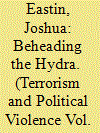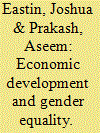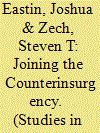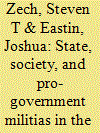|
|
|
Sort Order |
|
|
|
Items / Page
|
|
|
|
|
|
|
| Srl | Item |
| 1 |
ID:
159898


|
|
|
|
|
| Summary/Abstract |
We evaluate the effectiveness of anti-insurgent violence as a means to suppress insurgency with micro-level data from the Iraq War. Our findings suggest that while violence against insurgents increases the incidence of future insurgent attacks, the intensity of this violence can significantly influence the outcome. Rather than shifting monotonically, the effect is actually curvilinear, first rising, and then contracting. We argue that at low to moderate levels, violence against insurgents creates opportunities for these groups to signal strength and resolve, which enables them to build momentum, heighten civilian cooperation, and diminish political support for counterinsurgency efforts in these forces’ home countries. The result is an escalation in insurgent attacks. However, at higher levels, this effect should plateau and taper off as insurgent attrition rises, and as civilian fears over personal safety displace grievances that might otherwise provoke counter-mobilization. Our empirical tests on data from the Iraq War, 2004–2009, demonstrate robust support for this argument.
|
|
|
|
|
|
|
|
|
|
|
|
|
|
|
|
| 2 |
ID:
119689


|
|
|
|
|
| Publication |
2013.
|
| Summary/Abstract |
This research note examines the relationship between economic development and gender equality. Drawing on the concept of the Kuznets curve, the authors hypothesize that the relationship between economic development and gender inequality is curvilinear (S shaped), with three distinct stages. In the first stage, economic development improves gender equality because it enables greater female labor-force participation. An independent income stream increases women's intrahousehold bargaining power. The opportunity to develop human capital confers greater political and social recognition. In the second stage, labor-force stratification and gender discrimination encourage divergent male/female income trajectories, which decrease the opportunity costs of female labor-force withdrawal and lend traction to social resistance against burgeoning gender norms. Consequently, there is a deceleration in initial equality gains. In the final stage, gender equality again improves, as greater educational participation and technological advancement provide new employment opportunities for women, increase the opportunity costs of staying home, and encourage the evolution of new social institutions and norms that overcome prior discriminatory practices. The authors find support for this argument in statistical tests of the relationship between economic development and gender equality on a panel of 146 developing countries for the period 1980-2005. They employ four indicators that reflect distinct dimensions of women's political, social, and economic status. They find economic development positively influences gender equality when per capita incomes are below $8,000-$10,000. These equality gains level off or decline slightly in the second stage, from $8,000-10,000 to about $25,000-$30,000. Beyond this level, economic development is again associated with improvements in gender equality. The key implication is that the effect of economic development on gender equality is contingent on the level of development. Policymakers and social activists should develop policy correctives to ensure that economic development confers improvements in gender equality across phases of development.
|
|
|
|
|
|
|
|
|
|
|
|
|
|
|
|
| 3 |
ID:
177838


|
|
|
|
|
| Summary/Abstract |
State security forces have been locked in an ongoing struggle with the Communist Party of the Philippines – New People’s Army (NPA) for nearly fifty years. Over the course of the conflict, thousands of civilians across generations have taken up arms and participated in the counterinsurgency campaign. Citizen Armed Force Geographical Units (CAFGU) and other pro-government militias have played a key auxiliary role in combatting the insurgency and providing community security. This article draws on survey and interview data collected from CAFGU participants to examine the factors that influence decisions to join, as well as their implications for sustained participation and counterinsurgency strategy. Existing research on joining armed groups recognizes how environmental conditions, group processes, and individual motives interact to help explain participation. We shift our focus to the realm of the household and highlight how considerations related to that site affect participation. Our findings suggest that the need to avoid economic disaster and ensure a secure subsistence can have a notable influence on decisions to enlist and individual experiences as CAFGU. These effects, in turn, have implications for how the Philippine government carries out its counterinsurgency.
|
|
|
|
|
|
|
|
|
|
|
|
|
|
|
|
| 4 |
ID:
188765


|
|
|
|
|
| Summary/Abstract |
What motivates civilians to fight in a progovernment militia? This article draws on survey and interview data from active members of Citizen Armed Forces Geographical Units (CAFGU), a progovernment militia in the Philippines, to evaluate why individuals enlist. We find poverty and unemployment to be key drivers of group membership, and the biggest attraction a steady paycheck. This situation presents a moral hazard for the Philippine government and other states that rely on impoverished citizens to wage counterinsurgency: while doing so can be cost-effective, the need to keep costs low might also impede efforts at socioeconomic or political reform.
|
|
|
|
|
|
|
|
|
|
|
|
|
|
|
|
| 5 |
ID:
191004


|
|
|
|
|
| Summary/Abstract |
Examining militia relationships with the government and civilian populations can help scholars and policymakers better assess differences in militia form, function, and behavior. In this article, we examine the Civilian Armed Forces Geographical Units (CAFGU), a pro-government militia in the Philippines, to better understand how militia participants view insurgents, politicians, state security forces, and civilians based on their experiences serving in the group. We argue that analyzing these beliefs is critical to understanding how militias influence civilian security and the risk of political violence in conflict-contested areas, as well as the trajectory of civil conflict in states like the Philippines that rely on militias to perform core security functions. We base the analysis on surveys and interviews with CAFGU members and civilians living in the Eastern Visayas, a region of active and ongoing conflict, where insurgents and other armed militants advance their aims through acts of violence and terrorism. In doing so, we contribute to a growing literature on the role that militias play in civil war, as well as the implications that follow when states choose to arm “civilians” to aid in counterinsurgency and conflict suppression.
|
|
|
|
|
|
|
|
|
|
|
|
|
|
|
|
|
|
|
|
|